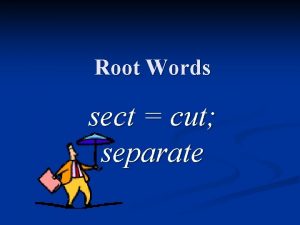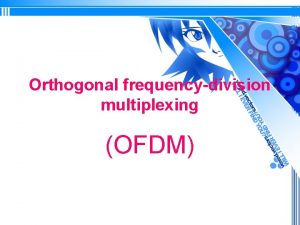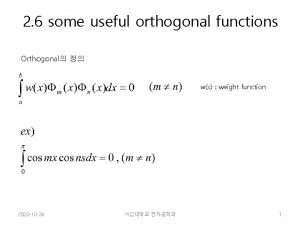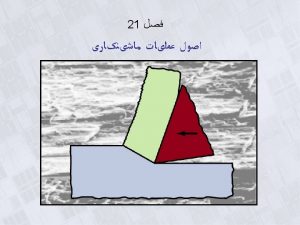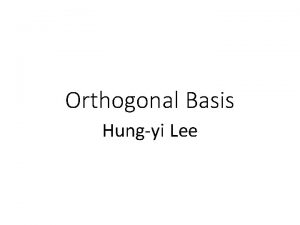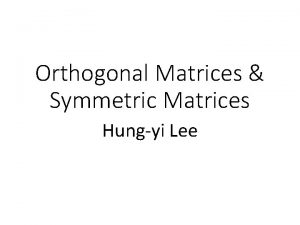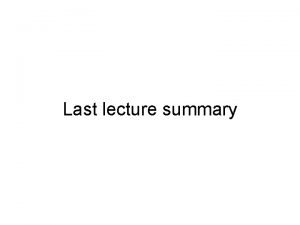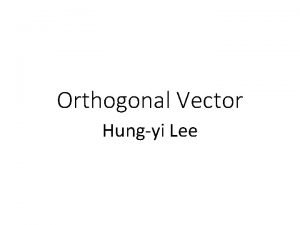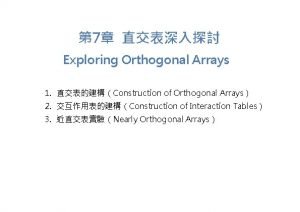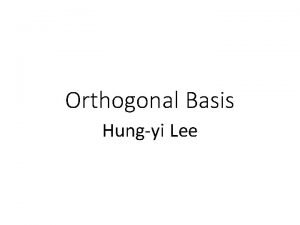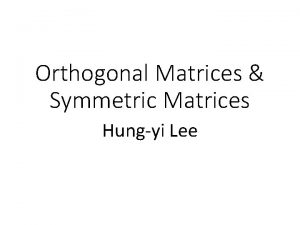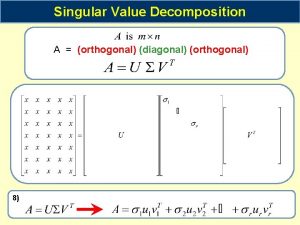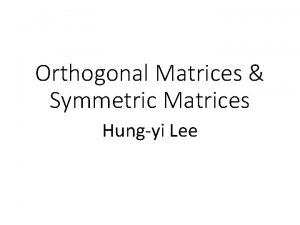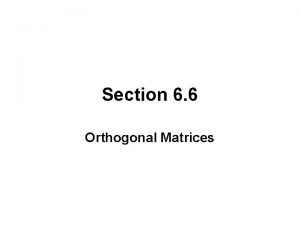Sect 4 2 Orthogonal Transformations For convenience change


























- Slides: 26


Sect. 4. 2: Orthogonal Transformations • For convenience, change of notation: x x 1, y x 2, z x 3, x´ x 1 , y´ x 2 , z´ x 3 aij cosθij • In new notation, transformation eqtns between primed & unprimed coords become: x 1 = a 11 x 1+a 12 x 2 +a 13 x 2 = a 21 x 1+a 22 x 2 +a 23 x 3 = a 31 x 1+a 32 x 2 +a 33 x 3 Or: xi = ∑j aij xj (i, j = 1, 2, 3) (1) • (1) = An example of what mathematicians call a Linear (or Vector) Transformation. Also:

• For convenience, another change of notation: If the index is repeated, summation over it is implied. xi = ∑j aij xj (i, j = 1, 2, 3) xi = aij xj (i, j = 1, 2, 3) Einstein summation convention • To avoid possible ambiguity when powers of an indexed quantity occur: ∑i(xi)2 xixi • For the rest of the course, summation convention is automatically assumed, unless stated otherwise.

• Linear Transformation: xi = aij xj (i, j = 1, 2, 3) (1) • With aij cosθij as derived, (1) is only a special case of a general linear transformation, since, as already discussed, the direction cosines cosθij are not all independent. – Re-derive connections between them, use new notation. • Both coord systems are Cartesian: Square of magnitude of vector = sum of squares of components. Magnitude is invariant on transformation of coords: xi xi = xixi Using (1), this becomes: aijaikxjxk = xixi (i, j, k = 1, 2, 3)

• aijaikxjxk = xixi (i, j, k = 1, 2, 3) Can be valid if & only if aijaik = δj, k (j, k = 1, 2, 3) Identical previous results for orthogonality of direction cosines. • Any Linear Transformation: xi = aij xj (i, j = 1, 2, 3) (1) Orthogonal Transformation aijaik = δj, k Orthogonality Condition

• Linear (or Vector) Transformation. xi = aijxj (i, j = 1, 2, 3) (1) • Can arrange direction cosines into a square matrix: A a 11 a 12 a 13 a 21 a 22 a 23 a 31 a 32 a 33 • Consider coordinate axes as column vector components: r = x 1 x 2 x 3 r = x 1 x 2 Coordinate transformation reln can be written: r = Ar with A Transformation matrix or rotation matrix (or tensor)

Example: 2 d Coordinate Rotation • Application to 2 d rotation. See figure: • Easy to show that: x 3 = x 3 x 1 = x 1 cos + x 2 sin = x 1 cos + x 2 cos( - π/2) x 2 = -x 1 sin + x 2 cos = x 1 cos( + π/2) + x 2 cos

• 2 d rotation. See fig: aij cosθij a 33 = cosθ 33 = 1 a 11 = cosθ 11 = cos a 22 = cosθ 22 = cos a 12 = cosθ 12 = cos( - π/2) = sin a 21 = cosθ 21 = cos( + π/2) = -sin a 31 = cosθ 31 = cos(π/2) = 0, a 32 = cosθ 32 = cos(π/2) = 0 Transformation matrix has form: a 11 a 12 0 cos sin 0 A= a 21 a 22 0 = -sin cos 0 0 0 1

• 2 d rotation. See fig: aij cosθij Orthogonality Condition: aijaik = δj, k a 11 + a 21 = 1 a 12 + a 22 = 1 , a 11 a 12 + a 21 a 22 = 0 Use expressions for aij & get: cos 2 + sin 2 =1 sin 2 + cos 2 =1, cos sin - sin cos = 0 Need only one angle to specify a 2 d rotation.

• Transformation matrix A Math operator that, acting on unprimed system, transforms it to primed system. Symbolically: r = Ar (1) Matrix A, acting on components of the r in unprimed system yields components of r in the primed system. • Assumption: Vector r itself is unchanged (in length & direction) on operation with A. (r 2 = (r )2) • NOTE: Same formal mathematics results from another interpretation of (1): A acts on r & changes it into r . Components of 2 vectors related by (1). • Which interpretation depends on context of problem. Usually, for rigid body motion, use 1 st interpretation. • For general transformation (1), nature of A depends on which interpretation is used. A acting on coords: Passive transformation. A acting on vector: Active transformation

Example from Marion • In the unprimed system, point P is represented as (x 1, x 2, x 3) = (2, 1, 3). In the primed system, x 2 has been rotated from x 2, towards x 3 by a 30º angle as in the figure. Find the rotation matrix A & the representation of P = (x 1 , x 2 , x 3 ) in the primed system.

• From figure, using aij cosθij a 11 = cosθ 11 = cos(0º) =1 a 12 = cosθ 12 = cos(90º) = 0 a 13 = cosθ 13 = cos(90º) = 0 a 21 = cosθ 21 = cos(90º) = 0 a 22 = cosθ 22 = cos(30º) = 0. 866 a 23 = cosθ 23 = cos(90º-30º) = cos(60º) = 0. 5 a 31 = cosθ 31 = cos(90º) = 0 a 32 = cosθ 32 = cos(90º+30º) = -0. 5 a 33 = cosθ 33 = cos(30º) = 0. 866 A = 1 0 0. 866 -0. 5 0. 866

• To find new representation of P, apply r = Ar or x 1 = a 11 x 1+a 12 x 2 +a 13 x 2 = a 21 x 1+a 22 x 2 +a 23 x 3 = a 31 x 1+a 32 x 2 +a 33 x 3 Using (x 1, x 2, x 3) = (2, 1, 3) x 1 = 2 x 2 = 0. 866 x 2 +0. 5 x 3 = 2. 37 x 3 = -0. 5 x 2 + 0. 866 x 3 = 2. 10 (x 1 , x 2 , x 3 ) = (2, 2. 37, 2. 10)

Useful Relations • Consider a general line segment, as in the figure: Angles α, β, γ between the segment & x 1, x 2, x 3 Direction cosines of line cosα, cosβ, cosγ Manipulation, using orthogonality relns from before: cos 2α + cos 2β + cos 2γ = 1

• Consider 2 line segments, direction cosines, as in the figure: cosα, cosβ, cosγ, & cosα , cos β , cosγ • Angle θ between segments: • Manipulation (trig): cosθ = cosα +cosβ +cosγ

Sect. 4. 3: Formal (math) Properties of the Transformation Matrix • For a while (almost) pure math! • 2 successive orthogonal transformations B and A, acting on unprimed coordinates: r = Br followed by r = Ar = ABr • In component form, application of B followed by A gives (summation convention assumed, of course!): xk = bkjxj , xi = aikxk = aikbkjxj (1) (i, j, k = 1, 2, 3) xi = cijxj (2) • (2) has the form of an orthogonal transformation C AB with elements of the square matrix C given by cij aikbkj Rewrite (1) as:

Products Product of 2 orthogonal transformations B (matrix elements bkj) & A (matrix elements aik) is another orthogonal transformation C = AB (matrix elements cij aikbkj). – Proof that C is also orthogonal: See Prob. 1, p 180. • Can show (student exercise!): Product of orthogonal transformations is not commutative: BA AB – Define: D BA (matrix elements dij bikakj). Find, in general: dij cij. Final coords depend on order of application of A & B. • Can also show (student exercise!): Products of such transformations are associative: (AB)C = A(BC)

• Note: Text now begins to use vector r & vector x interchangeably! r = Ar x = Ax can be represented in terms of matrices, with coord vectors being column vectors: x = Ax xi = aijxj or: x 1 a 12 a 13 x 1 x 2 = a 21 a 22 a 23 x 2 a 31 a 32 a 33 x 3 • Addition of 2 transformation matrices: C = A + B Matrix elements are: cij = aij + bij

Inverse • Define the inverse A-1 of transformation A: x = Ax (1), x A-1 x (2) In terms of matrix elements, these are: xk = akixi (1 ), xi aij xj (2 ) where aij are matrix elements of A-1 • Combining (1 ) & (2 ): xk = akiaij xj clearly, this can hold if & only if: akiaij = δj, k (3 ) Define: Unit Matrix 1 0 0 1 0 akiaij = δj, k are clearly matrix 0 0 1 elements of 1

Transpose In terms of matrices, DEFINE A-1 by: AA-1 A-1 A 1 – Proof that AA-1 A-1 A : p 146 of text. • 1 Identity transformation because: x = 1 x and A = 1 A • Matrix elements of A-1 & of A are related by: aij = aji (4) – Proof of this: p 146 -147 of text. • Define: Ã Transpose of A matrix obtained from A by interchanging rows & columns. Clearly, (4) A-1 = Ã & thus: ÃA = AÃ = 1

A-1 = Ã For orthogonal matrices, the reciprocal is equal to the transpose. • Combine aij = aji with akiaij = δj, k akiaji = δj, k (5): A restatement of the orthogonality relns for the aki ! • Dimension of rectangular matrix, m rows, n columns m n. A, A-1, Ã : Square matrices with m = n. – Column vector (1 column matrix) x, dimension m 1. Transpose x: dimension 1 m (one row matrix). – Matrix multiplication: Product AB exists only if # columns of A = # rows of B: cij = aikbkj – See text about multiplication of x & its transpose with A & Ã

Define: • Symmetric Matrix A square matrix that is the same as its transpose: A = Ã aij = aji • Antisymmetric Matrix A square matrix that is the negative of its transpose: A = - Ã aij = - aji – Obviously, diagonal elements in this case: aii = 0

• 2 interpretations of orthogonal transformation Ax = x – 1) Transforming coords. 2) Transforming vector x. • How does arbitrary vector F (column matrix) transform under transformation A? Obviously, G AF (some other vector). • If also, the coord system is transformed under operation B, components of G in new system are given by G BAF Rewrite (using B-1 B = 1) as: G = BAB-1 BF Also, components of F in new system are given by F BF

• Combining gives: G = BAB-1 F where: F BF, G BG If define operator BAB-1 A we have: G A F (same form as G = AF, but expressed in transformed coords) Transformation of operator A under coord transformation B is given as: A BAB-1 Similarity transformation

• Properties of determinant formed from elements of an orthogonal transformation matrix: det(A) |A| Some identities (no proofs): • |AB| = |A||B| From orthogonality reln ÃA = AÃ = 1 get • |Ã||A| = |A||Ã| = 1 Determinant is unaffected by interchange of rows & columns: • |Ã| = |A| Using this with above gives: • |A|2 = 1 |A| = 1

• Value of determinant is invariant under a similarity transformation. Proof: A, B orthogonal transformations – Assumes 1) B-1 exists & 2) |B| 0 Similarity transformation: A BAB-1 Multiply from right by B: A B = BAB-1 B = BA Determinant: |A ||B| = |B||A| (|B| = a number 0) Divide by |B| on both sides & get |A | = |A|
 Sect root word
Sect root word Magnetsjukhus
Magnetsjukhus Borstål, egenskaper
Borstål, egenskaper Personalliggare bygg undantag
Personalliggare bygg undantag Shivaismen
Shivaismen Centrum för kunskap och säkerhet
Centrum för kunskap och säkerhet Inköpsprocessen steg för steg
Inköpsprocessen steg för steg Slyngexcision
Slyngexcision Bo bergman jag fryser om dina händer
Bo bergman jag fryser om dina händer Strategi för svensk viltförvaltning
Strategi för svensk viltförvaltning Varians
Varians Datorkunskap för nybörjare
Datorkunskap för nybörjare Tack för att ni har lyssnat
Tack för att ni har lyssnat Läkarutlåtande för livränta
Läkarutlåtande för livränta Klassificeringsstruktur för kommunala verksamheter
Klassificeringsstruktur för kommunala verksamheter Returpilarna
Returpilarna Påbyggnader för flakfordon
Påbyggnader för flakfordon Tack för att ni lyssnade
Tack för att ni lyssnade Tobinskatten för och nackdelar
Tobinskatten för och nackdelar Egg för emanuel
Egg för emanuel Atmosfr
Atmosfr Lågenergihus nyproduktion
Lågenergihus nyproduktion Personlig tidbok
Personlig tidbok Rutin för avvikelsehantering
Rutin för avvikelsehantering Mitos steg
Mitos steg Presentera för publik crossboss
Presentera för publik crossboss Rbk fuktmätning
Rbk fuktmätning
